The Health Education Assets Library (HEAL) is a collection of over 22,000 freely available digital materials for health sciences education. The collection is now housed at the University of Utah J. Willard Marriott Digital Library.
TO
| Title | Description | Subject | Collection | ||
|---|---|---|---|---|---|
| 76 |
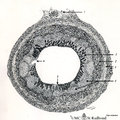 |
Scheme of appendix ('gut-associated lymphatic tissue' or GALT) (human) | Survey vermiform appendix (see also Digestive System: Appendix) A large amount of non-encapsulated diffuse lymphatic tissue or mucosa-associated lymphatic tissue (MALT) is located in the subepithelial lamina propria (e.g. respiratory passages, genitourinary tract). The gut-associated lymphatic tis... | GALT; follicle; scheme; germinal center | Poja Histology Collection - Lymphatic Tissues and Organs Subset |
| 77 |
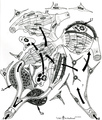 |
Scheme of blood circulation in the red pulp in the spleen | A. closed circulation B. open circulation A. The route of closed circulation proposes that blood empties from the capillaries directly into the splenic sinus. The central artery bifurcates into penicillar arterioles (1) and the blood slowly enters ensheathed capillaries, surrounded by agg... | white pulp; marginal zone; red pulp; open circulation | Poja Histology Collection - Lymphatic Tissues and Organs Subset |
| 78 |
 |
Scheme of development of germinal centre in lymphatic nodule (human) | A. primary nodule (or follicle) with mainly nave B lymphocytes and some memory cells, but no germinal centre; B. proliferation of lymphoblasts by mitosis (3,-->) and development of capillaries (*) in the centre of the follicle; C. so-called secondary nodule with lighter stained germinal centre wit... | follicle; antigen stimulation; scheme; germinal center | Poja Histology Collection - Lymphatic Tissues and Organs Subset |
| 79 |
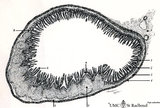 |
Scheme of ileum with Peyers patches (gut-associated lymphatic tissue or GALT) (dog) | Survey ileum (see also Digestive System: Ileum) A large amount of non-encapsulated diffuse lymphatic tissue or mucosa-associated lymphatic tissue (MALT) is located in the subepithelial lamina propria (e.g. respiratory passages, genitourinary tract). The gut-associated lymphatic tissues (GALT) are ... | GALT; follicle; scheme; germinal center | Poja Histology Collection - Lymphatic Tissues and Organs Subset |
| 80 |
 |
Scheme of lingual tonsil ('lymphoepithelial tissue') | Lingual tonsil (consisting of the accumulation of folliculi linguales). The root of the tongue contains invaginations or crypts or narrow caverns (3). In these crypts the ducts of the mucous glands (8) end up. The crypts are lined by multilayered, non-keratinizing squamous epithelium (2) and are sur... | lingual tonsil; scheme; germinal center; follicle | Poja Histology Collection - Lymphatic Tissues and Organs Subset |
| 81 |
 |
Scheme of lymph node (human) | Lymph node: A. survey; B. detail subcapsular (or marginal) sinus 1. adipose tissue; 2. capsule; 3. afferent lymph vessel with valves (B); 4. subcapsular (or marginal) sinus; 5. germinal centre of a secondary lymphatic nodule (or follicle); 6. crescent or mantle zone indicated by cap of per... | cortex; scheme; paracortex; germinal center | Poja Histology Collection - Lymphatic Tissues and Organs Subset |
| 82 |
 |
Scheme of palatine and pharyngeal tonsils ('lymphoepithelial tissues') (human) | The palatine tonsils are covered by the multilayered, non-keratinizing squamous epithelium of the oral cavity (A-1). In contrast to the palatine and lingual tonsils, the epipharyngeal tonsil has a multilayered ciliated epithelium (respiratory-like epithelium, B-9). The Waldeyer's tonsillar ring i... | germinal center; scheme; follicle | Poja Histology Collection - Lymphatic Tissues and Organs Subset |
| 83 |
 |
Scheme of reticular tissue in lymph node | Lymph node stroma does not contain stromal cells but instead the reticular meshwork is build by reticular cell types, macrophages and lymphoid cells and myeloid cells. Route (A) in the scheme represents morphological differentiation path from B lymphocytes to plasma cells. 1 endothelial ce... | reticular tissue; scheme; follicle; germinal center | Poja Histology Collection - Lymphatic Tissues and Organs Subset |
| 84 |
 |
Scheme of secondary lymphatic nodule in spleen (human) | A. histological impression of a follicle or nodule B. outline of impression 1. pulpa artery; 2. central artery ; 3. lymphatic sheath; 4. lymphatic nodule; 5. thymus-dependent area (periarteriolar lymphatic sheath or PALS), composed of Th subset lymphocytes; 6. mantle zone with mainly nave B l... | white pulp; marginal zone; antigen presenting cell (APC) | Poja Histology Collection - Lymphatic Tissues and Organs Subset |
| 85 |
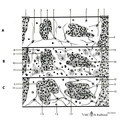 |
Scheme of the medullar changes in lymph node after antigen stimulation | Upon antigenic stimulation the reticular cells that line the medullar sinusoids start to phagocytise the antigens (i.e. infective agents) and change from small tiny stellate cells into swollen large cells due to phagocytosis. They detach from the medullar sinus wall. After ten days the situation has... | follicle; antigen stimulation; scheme; germinal center | Poja Histology Collection - Lymphatic Tissues and Organs Subset |
| 86 |
 |
Scheme of the spleen (human) | Spleen: A. general diagram; B. adult; C. senium 1. capsule of dense irregular connective tissue with few elastic and smooth muscle fibers (it varies with the species); 2. trabecula (septum); 3. trabecular artery derived from the splenic artery; 4. trabecular vein; 5. when the pulpa artery ... | white pulp; red pulp | Poja Histology Collection - Lymphatic Tissues and Organs Subset |
| 87 |
 |
Scheme of the thymus during ageing (human) | Physiological changes in the course of human ageing lead to almost complete degeneration of the thymus (age involution). Both cortex and medulla become depleted of lymphocytes, and the distinction between both layers gradually becomes less. The remaining reticular meshwork of connective tissue is gr... | thymus involution; thymus development; thymus age; lymphoid tissue | Poja Histology Collection - Lymphatic Tissues and Organs Subset |
| 88 |
 |
Scheme of the thymus medulla (human) | A-B: medullar epithelioreticular cells; C-D-E: development stages of thymic corpuscles (or Hassall bodies) (1): branching (-->) epithelioreticular cells in the medulla forming a meshwork (cytoreticulum) that normally is populated by thymocytes; (2): specialized epithelioreticular cells (2) often... | thymic corpuscle; Hassall ; epithelioreticular cells ; lymphoid tissue | Poja Histology Collection - Lymphatic Tissues and Organs Subset |
| 89 |
 |
Secondary lymphatic nodule in the spleen (human) | Stain: Trichrome (Goldner). A: Survey of a follicle in the spleen. B: a higher magnification of a similar section shows part of a lymphatic nodule (follicle, white pulp) with cross-sections of the central artery (6). (1) germinal centre (filled with reticular cells, B-memory lymphocytes and macroph... | white pulp; PALS; germinal center; marginal zone | Poja Histology Collection - Lymphatic Tissues and Organs Subset |
| 90 |
 |
Section of lymph node (human) | Stain: Silver stain (Gomori). Due to the argyrophilia the reticular fibers are black-stained. They are derived from the fibrous capsule and penetrate into the deep cortex (i.e. paracortical area) and are embedded among other fibers such as collagen type III, IV. Note the postcapillary venules (*) ... | high endothelial venule (HEV); paracortex; argyrophilia; paracortex | Poja Histology Collection - Lymphatic Tissues and Organs Subset |
| 91 |
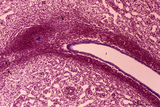 |
Spleen with central artery in lymphatic nodule (human) | Stain: Azan. A longitudinally cut central artery (1) of a lymphatic nodule or follicle, (white pulp) is invested by a distinct lymphatic sheath (PALS) composed of concentric layered T lymphocytes) (2). The red pulp consists of open venous sinusoids (4) and splenic cords (5, Billroth) with macrophage... | central artery; PALS; sinusoid ; Billroth | Poja Histology Collection - Lymphatic Tissues and Organs Subset |
| 92 |
 |
Spleen with central artery in lymphatic nodule (human) | Stain: A: Silver stain (Gomori). B: Trichrome (Goldner). In A: the reticular fibers (2) around the PALS (periarteriolar lymphatic sheath) and continuing in and around the marginal zone are stained black, illustrating the reticular framework of the lymphatic nodule. (1) central arteries. (4) red pulp... | central artery; PALS; white pulp; T cells | Poja Histology Collection - Lymphatic Tissues and Organs Subset |
| 93 |
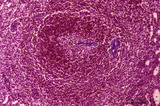 |
Spleen with central artery in secondary lymphatic nodule (human) | Stain: Azan. The white pulp consists of (1) a cross-section of the central artery, (2) the germinal centre with few branches of the central artery; the mantle zone (3) and the marginal zone (4) surrounded by a perilymphoid zone around the nodule. The perilymphoid zone is composed of concentricall... | germinal center; PALS; central artery; marginal zone | Poja Histology Collection - Lymphatic Tissues and Organs Subset |
| 94 |
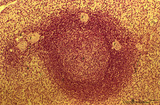 |
Spleen with secondary lymphatic nodule (human) | Stain: Hematoxylin & eosin. The splenic follicle as part of the white pulp is arranged around the cross sectioned central artery (1).The lymphatic sheath or PALS is composed of T cells (2). The darker stained mantle zone of mainly nave B lymphocytes (3) encompasses the lighter stained germinal centr... | white pulp; PALS; marginal zone; mantle layer | Poja Histology Collection - Lymphatic Tissues and Organs Subset |
| 95 |
 |
Spleen with secondary lymphatic nodule (human) | Stain: Azan. The white pulp of this perfused spleen consists of: at (1) a cross-section of the central artery, (2) tangential cut mantle zone and (3) the marginal zone. The red pulp contains empty venous sinusoids (4) and the perilymphoid zone (3a) is the zone of red pulp immediately surrounding ... | white pulp; germinal center; follicle; white pulp | Poja Histology Collection - Lymphatic Tissues and Organs Subset |
| 96 |
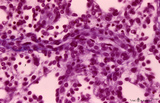 |
Splenic sheathed capillaries (human) | Stain: Azan. The blood flow in the spleen goes from splenic artery to trabecular artery to central or follicular artery (with a periarteriolar lymphatic sheath or PALS), and upon leaving the follicle the blood flows through penicillar arterioles and sheathed capillaries and terminal arterial capilla... | penicillar arterioles; red pulp; sheathed capillaries | Poja Histology Collection - Lymphatic Tissues and Organs Subset |
| 97 |
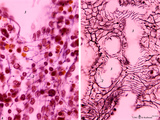 |
Splenic sinusoids (human) | Stain: A: Azan and B: Silver stain (Gomori). The splenic sinusoids are built in the form of a grid. The frame of the barrel consists of elongated endothelial cells (1) which are spirally wrapped around by reticular fibers (2). To this reticular fibers are attached many macrophages which control the... | sinusoid; reticular fibers | Poja Histology Collection - Lymphatic Tissues and Organs Subset |
| 98 |
 |
Splenic venous sinusoid in red pulp (rat) | Immunoelectron microscopy (gold labeling of heparan sulfate in Lowicryl embedding, using the single chain antibody HS4C3). (1) shows the open lumen of a venous sinusoid filled with few electron-dense erythrocytes and lining cells (2). (3) marks a neutrophilic granulocyte. (4) points to the diaped... | sinusoid; immuno electron microscopy; heparan sulfate | Poja Histology Collection - Lymphatic Tissues and Organs Subset |
| 99 |
 |
Survey and details of palatine tonsil ('lymphoepithelial tissues', 'gut-associated lymphatic tissue' or GALT) (human) | Stain: Azan. The survey in (A) shows that the palatine tonsil (localized in the lateral wall of the oropharynx) consists of crypts (1) and folds of the surface epithelium (stratified squamous) surrounded by accumulations of lymphoid cells organized in follicles (2). (B): the lining epithelium (5) i... | stratified squamous epithelium | Poja Histology Collection - Lymphatic Tissues and Organs Subset |
| 100 |
 |
Survey of pharyngeal tonsil ('lymphoepithelial tissues', 'gut-associated lymphatic tissue' or GALT) (human) | Stain Azan. The solitary pharyngeal tonsil is localized in the pharyngeal fornix and belongs to the so-called Waldeyer's ring of pharyngeal lymphatic tissue. A survey shows the folded columnar epithelium (1) with faintly light-stained goblet cells with clefts (2) in between. The lamina propria co... | pharyngeal tonsil; GALT | Poja Histology Collection - Lymphatic Tissues and Organs Subset |
